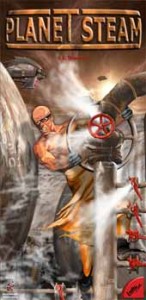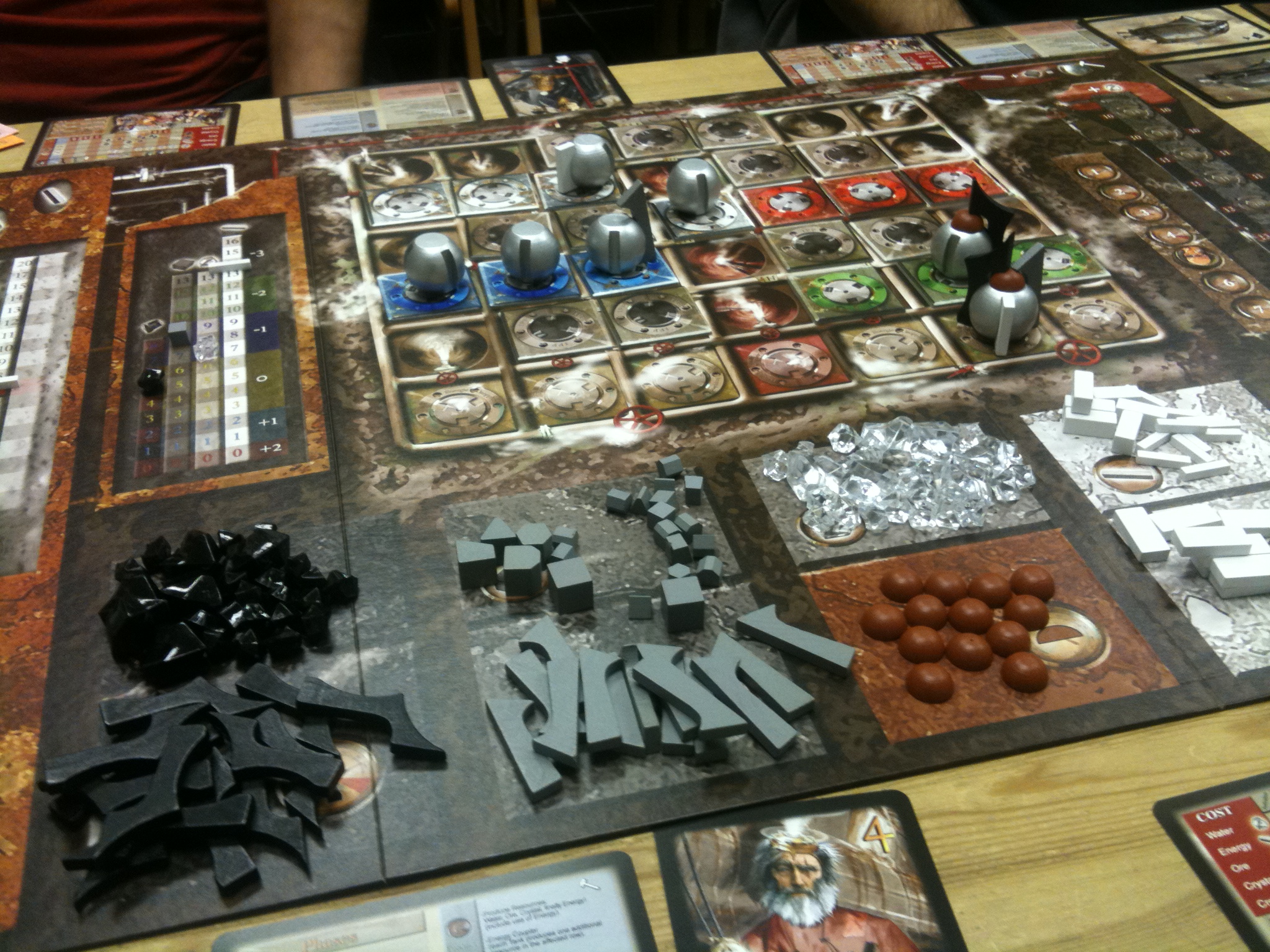Thoughts On: Planet Steam
Posted by James (admin) on September 15th, 2010
 Planet steam is an economic/resource game that was released at Essen in 2008. It was a sought after item in an epic-sized box (like a FantasyFlight Games big box size). With a steampunk setting, players collect resources (water, ore, energy and quartz) from the available mine shafts in order to earn as much money as possible. This is a ‘Thoughts On’ piece rather than a review as Planet Steam is a very interwoven economic system and I don’t feel one play is enough for a full review.
Planet steam is an economic/resource game that was released at Essen in 2008. It was a sought after item in an epic-sized box (like a FantasyFlight Games big box size). With a steampunk setting, players collect resources (water, ore, energy and quartz) from the available mine shafts in order to earn as much money as possible. This is a ‘Thoughts On’ piece rather than a review as Planet Steam is a very interwoven economic system and I don’t feel one play is enough for a full review.
Players have a few starting resources and the basic carriers (which are the stores for each resource with limited capacity). Also, the board shows a grid of mine shafts. Each shaft can produce any resource depending upon what type of tank is placed on it. Each player has a few platforms already on the mine shaft grid which means they are the only ones that can add tanks in order to mine from that space. At the start of a round, players bid for characters which dictate turn order and give them a special power. We played with 4 played so just saw 4 of the 5 characters. Number 1 just let’s you go first, 2 let’s you choose a mine shaft to auction which you pay only half the bid if you win it, 3 let’s you pick a row of mining platforms which will all produce double this turn, and 4 gives you a building permit or 15 credits.
After selecting characters, players play each phase in character number order. First, players bid to build a platform on a shaft selected by the character 2 player, then each player gets to build a shaft with a 50:50 chance of success. Players can use building permits to guarantee success and/or build over a neutral platform. Next, players buy things like tanks (which allow the production of water), tank upgrades (allowing a tank to produce ore, quartz or energy instead of water), carrier upgrades (to increase the amount of resources a player can hold), building permits, and other items. Buying items costs resources and sometimes cash too. Next, players produce resources by spending 1 energy to activate each of their tanks, apart from producing energy which doesn’t require energy. Finally, players can buy or sell each of the resources – all buying and selling of one resource is completed before the next and always in player order. This is important because the game only starts with a few resources available so there is a limit to how many can be bought and the only way for more to be available is for a player to sell some. What is bought and/or sold affects the prices of each resource.
 That gives you the basic idea of the game. I had a very difficult game – partially because we were learning how the game mechanics combined with each other and learning what values were sensible when bidding, but also because I was in the wrong place at the wrong time. For example, when I was first in the turn order, I couldn’t buy the resources I needed because there weren’t any available, and going first means no-one else had a chance to sell any into the market (making them available for purchase) before my turn. Conversely, in a different turn, I wanted to buy a resource of which there were plenty but was last in the turn order which meant they were all gone (bought by the other players) before I had the chance to purchase them. So, whilst I had cash and a plan, I was severely limited by these situations as it meant I couldn’t build what I needed.
That gives you the basic idea of the game. I had a very difficult game – partially because we were learning how the game mechanics combined with each other and learning what values were sensible when bidding, but also because I was in the wrong place at the wrong time. For example, when I was first in the turn order, I couldn’t buy the resources I needed because there weren’t any available, and going first means no-one else had a chance to sell any into the market (making them available for purchase) before my turn. Conversely, in a different turn, I wanted to buy a resource of which there were plenty but was last in the turn order which meant they were all gone (bought by the other players) before I had the chance to purchase them. So, whilst I had cash and a plan, I was severely limited by these situations as it meant I couldn’t build what I needed.
However, whilst I had a difficult game, which made it a less enjoyable experience than it should have been, I think planet Steam is a very good gamer’s game. It has a very tight and unforgiving economic system but that just means you need to think that much harder. There are a lot of decisions to be made but, after a few turns, the game flow is clear and you can concentrate on how to use the game mechanics to earn cash. I think most of us felt we’d do things differently next time now that we know how it plays and the usefulness of each resource changes though the game.
There did seem to be a set pattern in the way you should use resources. Water is more important at the start of the game, quartz at the end of the game and energy is needed throughout. I’m hoping this isn’t the case as it would make the gameplay a bit more prescribed. I found it was easy to get carried away building things – as usually building things in games is a good thing – but it should always be remembered that the goal is cash. Building a platform and tank to gather resources seems natural but might cost you more in materials than the cash you’ll end up generating from its production. So, you need to consider the opportunity costs of your actions. Note that platforms and tanks are worth money at the end of the game so this should be factored in too.
The steampunk setting is a nice change and I like it, although I suspect it held back the game’s popularity and appeal in some countries. I imagine it would have appealed to a wider gamer audience with a more traditional theme.
After playing the board game, I bought the recently released PC version. It’s relatively basic in its presentation but well executed which makes it easy to see what each player does during each phase (which is often not the case in PC board game conversions where the AI players just instantly complete a turn). With AI players, you can play a game much more quickly than the board game and I’m looking forwards to playing a few games and see if I can do better than my board game performance.
James.
[Played wih 4 players]


September 16th, 2010 at 3:07 am
Steampunk – what a refreshing setting for a game, different from anything I can remember. Steam Planet strikes me as a bit on the complex side, which I think I would like. We’ve been playing the same half-dozen or so favorites in my house for a while, so it would be good to sink our teeth into something a little more challenging and offbeat.